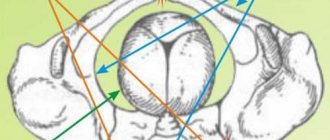Caesarean section operation
Caesarean section is an artificial method of delivery in which the baby is delivered through an incision in the anterior wall of the mother's abdomen and uterus. Such an operation can be carried out as planned - for medical reasons, if there are problems with the health of the mother in labor or the position of the child, when natural childbirth is contraindicated. Surgical births are also prescribed urgently when complications occur during natural childbirth, or when the life and health of mother and baby are threatened.
During the operation, at the final stage, the woman is given stitches on the uterus and abdomen, which, due to healing, leave a scar and a scar, respectively.
Before the onset of a new pregnancy, the scar on the uterus must be fully formed: it must consist of muscle tissue and its thickness must be at least 4 mm.
On average, it takes the female body from two to five years to completely heal the suture on the uterus. Therefore, pregnancy should be avoided during this period.
Surgical childbirth is carried out to preserve the health and life of mother and child.
The time required to recover after a cesarean section varies in each case and depends on the individual characteristics of the body.
Possible complications
A woman preparing for an abortion should learn in advance about possible complications. After all, the consequences of an abortion in such a situation can be irreparable.
After a mini-abortion, a woman’s egg may not be released, which will lead to inflammation and the need for additional intervention - after a cesarean section, in many women, the scars on the uterus heal very slowly. Therefore, abortions performed in the first year and a half after childbirth are especially dangerous.
When terminating a pregnancy using vacuum aspiration, problems may arise in the form of bleeding, and disturbances in the structure of the uterine mucosa also occur. High risk of inflammatory processes. Re-cleaning is possible.
The greatest risk of suffering from complications occurs during surgical abortion and induced birth. Instrumental abortion involves scraping out the embryo with an instrument, which will subject the uterine walls, which have been thinned after the operation, to additional damage.
Artificial childbirth is carried out extremely rarely, in cases of danger to the woman’s life. They are done between 20-24 weeks. To remove the fetus from the uterus, it is torn into pieces and then removed. Naturally, a number of complications after such an intervention cannot be avoided. The physical and mental state of the mother will be impaired.
Indications for termination of pregnancy after cesarean section
After surgical delivery, the body recovers more slowly than after natural childbirth.
The development of a new pregnancy during the first year after a cesarean section is strictly prohibited - the suture has not yet healed, the uterus has not been restored and is not able to cope with new loads. Otherwise, the scar may become thinner and separate during pregnancy or childbirth, which will pose a threat to the life of the mother and child, as well as lead to negative consequences.
If pregnancy occurs in a short time after surgical delivery, doctors give a recommendation for termination, since the woman’s chances of bearing a healthy child and not being harmed during childbirth are small.
If the gestation period lasts more than 12 weeks, then abortion is prohibited.
The longer the pregnancy, the higher the likelihood of gynecological complications after artificial termination.
An indication for abortion may be the presence of extragenital abnormalities in a woman - therapeutic, surgical, infectious - cardiovascular and circulatory systems, diabetes mellitus, tuberculosis, hepatitis and others. Such diseases can lead to pathology of fetal development or complications during the birth process.
Termination of pregnancy after surgical childbirth is extremely undesirable, as it can harm the weakened female body. Therefore, during the postpartum period, reliable methods of contraception should be used and unplanned conception should be avoided.
Spontaneous interruption
After conception, the fertilized egg may not always implant correctly. Caesarean section is accompanied by a restructuring of the hormonal system. If conception occurs quickly, less progesterone is produced. The embryo does not attach correctly. In this case, self-abortion is observed. Such an interruption is often accompanied by the sudden appearance of heavy bleeding. Many patients mistakenly believe that their period has arrived. Increased bleeding leads to weakness, nausea and pain. With such an abortion, it is necessary to quickly determine the cause. If this is not done, there is a risk of further deterioration of the reproductive organs.
Types of abortions
It is possible to terminate a pregnancy in three ways: medication, vacuum and surgery.
Medical abortion
After a caesarean section, the most gentle way to terminate a pregnancy is medication. This type of abortion is performed without surgery, using hormonal drugs. The pregnancy period at the time of this gynecological procedure should not exceed 6–7 weeks.
Medication interruption occurs in several stages:
- Before an abortion, a woman undergoes a gynecological examination on a chair and ultrasound diagnostics of the uterine cavity to exclude an ectopic pregnancy and determine the timing of pregnancy. It is also necessary to take blood and urine tests to obtain information about the woman’s health status.
- The pregnant woman takes three Mifepristone tablets and is under medical supervision for two hours. This drug has a destructive effect on the relationship between the uterus and the fertilized egg, which leads to the death of the embryo. Nagging pain appears in the lower abdomen, accompanied by mucous and bloody discharge from the genital tract.
- After two days, under the supervision of a specialist, the woman takes prostaglandins - hormone-like substances that cause uterine contractions (for example, Misoprostol or Alprostadil). The pulling pain in the lower abdomen intensifies, the discharge becomes bloody.
- After another two days, the woman is prescribed an ultrasound to determine the condition of the uterine cavity (in some cases, the fertilized egg under the influence of medications is not destroyed or is not completely expelled).
- Within two weeks after medication interruption, the patient undergoes a re-examination by a gynecologist and ultrasound diagnostics.
If a medical abortion does not take place, the pregnant woman will be forced to undergo a vacuum or surgical abortion procedure.
After a cesarean section, medical abortion is contraindicated during the first year after surgery.
Vacuum abortion
Vacuum termination of pregnancy is usually called a mini-abortion, in which a vacuum is created in the uterine cavity using a special device (electric vacuum pump) and the fertilized egg is sucked out. Duration: up to 6–8 weeks of pregnancy.
The walls and cervix are not injured after this method of abortion; only the mucous membrane is damaged. Therefore, this type of abortion is possible 6 months after artificial birth.
Before carrying out the abortion procedure, a pregnant woman must undergo blood and urine tests, undergo a gynecological examination and an ultrasound examination. In the absence of contraindications (ectopic pregnancy, acute infectious diseases, poor blood clotting), the doctor performs a vacuum abortion on the patient. The entire process takes place under local anesthesia and lasts about 10 minutes. The woman stays with the doctor for a short time after the abortion, then goes home. The doctor prescribes antibiotics to the patient to prevent inflammation, as well as painkillers for severe cramps. After two weeks, a gynecological examination and ultrasound examination are necessary.
If vacuum aspiration is unsuccessful, when part of the fertilized egg remains in the uterus, the termination is performed surgically - curettage.
Surgical abortion
Instrumental (surgical) abortion is undesirable for one and a half years after a cesarean section, since it is considered difficult and during medical manipulations the uterus that has not been restored after childbirth can be damaged. This method of termination is carried out up to 12 weeks of pregnancy in a hospital setting, using intravenous anesthesia. During the procedure, the doctor dilates the cervix and scrapes out the uterine cavity using special instruments.
The consequences of instrumental abortion after cesarean section can be negative and irreversible:
- infertility;
- violation of the integrity of the uterine scar;
- damage to the cervix;
- the occurrence of infection in the uterus;
- heavy bleeding.
Despite the fact that surgical abortion is contraindicated in the near future after surgical delivery, sometimes this type of termination of pregnancy may be the only way to preserve the health and life of a woman.
Termination of pregnancy at any stage of pregnancy can harm women's health
Long-term consequences
There are also long-term consequences of any abortion. They occur in every 3 women. Menstrual irregularities, infertility, the next desired pregnancy may be more difficult, with a constant threat of miscarriage.
Important! If the uterine mucosa is damaged as a result of an abortion, the work of the placenta is disrupted, the child suffers and may even lag behind in growth and development.
Thus, abortion always does more harm than good. And if an abortion is performed after a cesarean section, then the risk doubles. Therefore, it is better to use contraception on time.
5-6 months after cesarean, you can put a spiral. Take birth control pills. Even if you are breastfeeding, you can choose modern medications. Love yourself and be healthy!
Reviews
A year after the cesarean section, I had a vacuum aspiration (the so-called mini-abortion). quickly and non-traumatically. It is done before 5–6 obstetric weeks, and you can meet the deadline.
Guest
https://www.woman.ru/health/Pregnancy/thread/4735433/
I'm older, the same age as you. She carried to term normally and gave birth to a daughter, the first was a cesarean section, and the second was a planned cesarean section, everything went well. I can’t even imagine how it would be if my daughter didn’t exist, but everyone discouraged me from giving birth, they said it wasn’t possible. Only my gynecologist said that if the abortion is carried out with complications, then it will be very difficult to get pregnant, she said, there is no point in ruining your life.
Olya
https://www.babyblog.ru/community/post/health/1727005
The doctor is right. You already have a scar on the uterus, and curettage is an operation that damages the lining of the uterus, creating another scar. Can actually be cleaned several times. A tablet in your case will be a more gentle method. It’s a pity that the abortion... God grant that you don’t regret what you did and that you maintain your health. There are different situations in life. Take precautions in the future so that you don’t end up in a similar situation again.
Capitulo
https://galya.ru/clubs/show.php?dlimit=12&p=1&id=474460#allcomments
Two years ago, my child was born by emergency caesarean section. Throughout the entire postpartum period, unplanned pregnancies did not occur—my husband and I took a responsible approach to the choice of contraceptive methods. Therefore, it is difficult for me to imagine how women feel and what motivates them when choosing to terminate or continue a pregnancy - in any case, this is a big health risk. In my opinion, it is necessary to carefully monitor the situation when planning a new baby, because after a caesarean section the body needs rest and time to recover.
conclusions
To prevent a woman from having to terminate her pregnancy, an IUD should be installed six months after birth, which will solve the problem of contraception.
If pregnancy occurs, it is better to leave it than to terminate it.
If you decide to have an abortion, you need to carry out the procedure at the earliest stages, choosing vacuum aspiration or medication methods.
You can undergo an examination after a caesarean section, insert an intrauterine device, or undergo medical and vacuum abortions in the specialized abortion and contraception department at the Diana MGO.
MAKE AN APPOINTMENT
Before having an abortion, a woman must make an appointment with a gynecologist.
An initial consultation is necessary to confirm the fact of pregnancy, accurately determine the period, size and place of attachment of the fetus.
Based on the results of the consultation, a decision is made regarding the possibility of terminating the pregnancy and the optimal method of abortion is determined.
THE COST OF AN ABORTION IN OUR CLINIC FROM 4500 rubles. THE PRICE INCLUDES PILLS, APPOINTMENT WITH A GYNECOLOGIST EXAMINATION, AN ULTRASOUND TO DETERMINE THE DATE OF PREGNANCY!
Video: abortion and its consequences
Regardless of the number of pregnancies and how they end, women need to avoid unwanted conceptions. After all, the consequences of artificial termination of pregnancy can negatively affect the female body and lead to infertility, the risk is especially high in the short term after a cesarean section.
- Author: Anastasia Pashchenko
Anastasia Pashchenko, 27 years old. In 2013, she graduated from the Siberian Federal University, Humanitarian Institute, Faculty of History and Philosophy with a degree in archives and documentary management. I am currently on maternity leave. Rate this article:
- 5
- 4
- 3
- 2
- 1
(1 vote, average: 2 out of 5)
Share with your friends!
Uterine body
The uterus is an organ that is seriously affected during the abortion procedure.
The longer the gestation period, the more damage to the uterus. Curettage has the most negative impact on the condition of the organ. After removal of the fertilized egg, the uterine body slowly contracts. Gradually, over the course of several days, it acquires its original size. The endometrial layer is damaged, the uterine walls are injured. It takes time for everything to heal and return to generally accepted norms. It is believed that the condition of the uterus is completely restored within 4-5 weeks. When the menstrual cycle resumes, it functions normally again. The internal mucous membrane of the organ also meets the parameters. After one or two weeks, a visit to your attending gynecologist is required. Inspection is very important. If there is copious discharge mixed with blood and mucus, then an inflammatory process is occurring. It is possible that fetal particles remained in the uterine body after cleaning. Therefore, to avoid misunderstandings, an ultrasound is always performed. Based on its results, the doctor determines whether there are abnormal abnormalities and the cleanliness of the uterus. Then he prescribes restorative procedures.
Life after CS
Caesarean section (CS) is an abdominal operation, after which the woman spends the first hours under medical supervision in the intensive care unit.
It takes a month or two for the uterine suture to heal, and during this period it is important to avoid any stress (sudden movements, heavy lifting), and follow the rules of care to prevent infection of the suture. With proper care, an almost invisible thin scar remains on the skin. Intimate life is allowed after 1.5-2 months. In many ways, the healing time depends on the quality of the suture and the ability of the tissue to recover. But in any case, doctors warn the patient against another pregnancy for at least two or three years.










